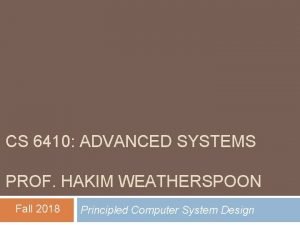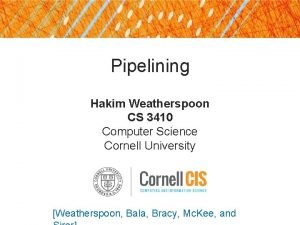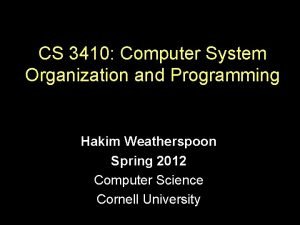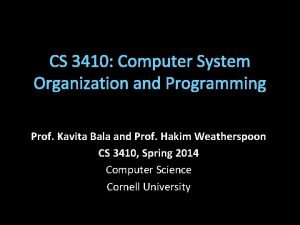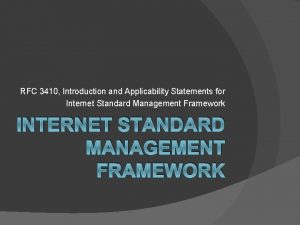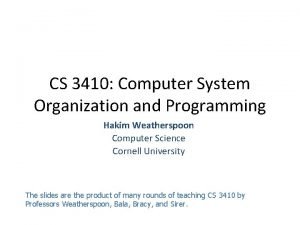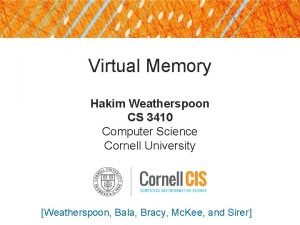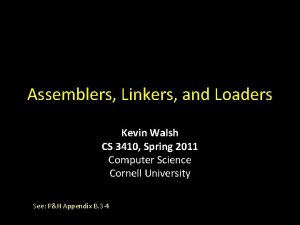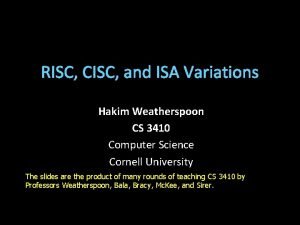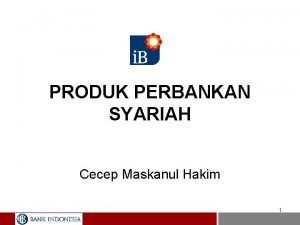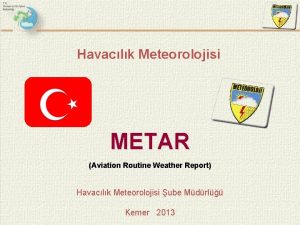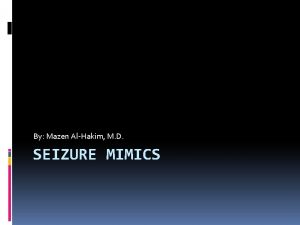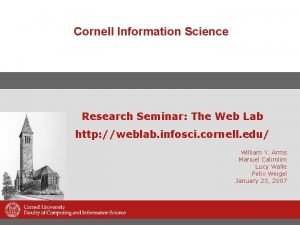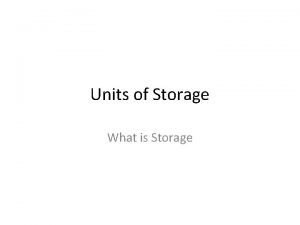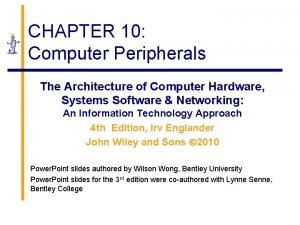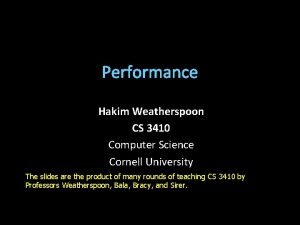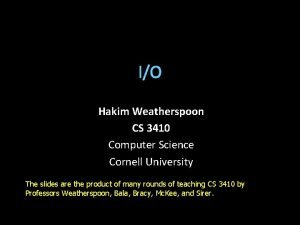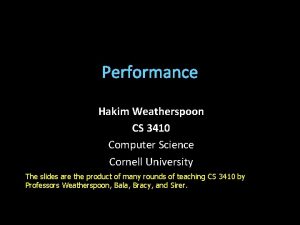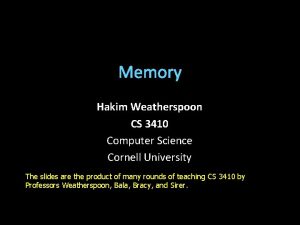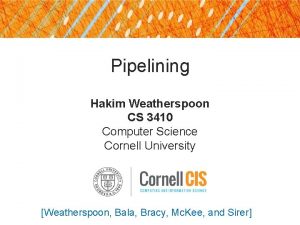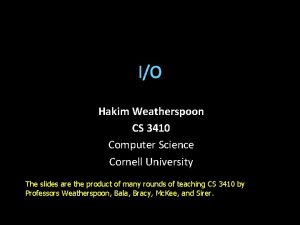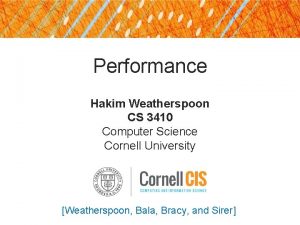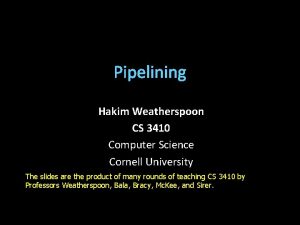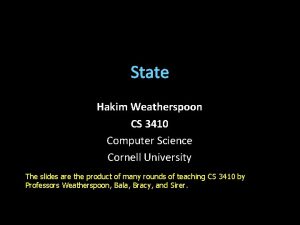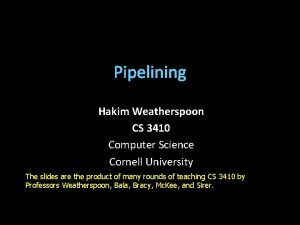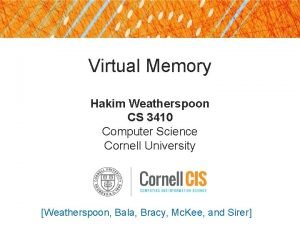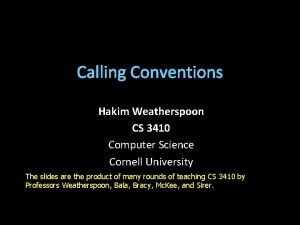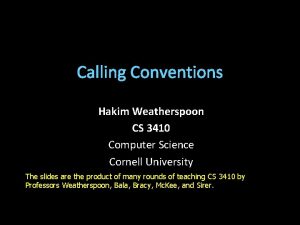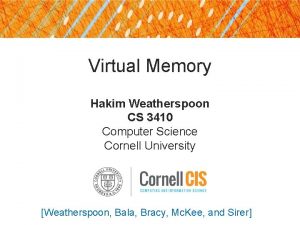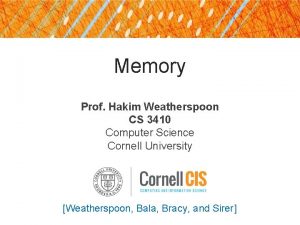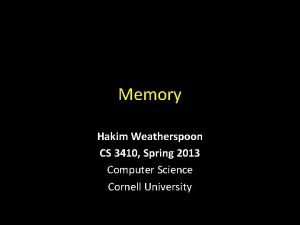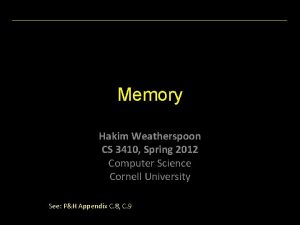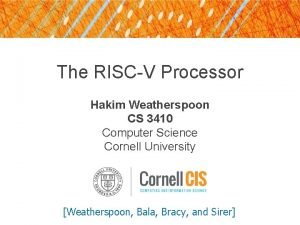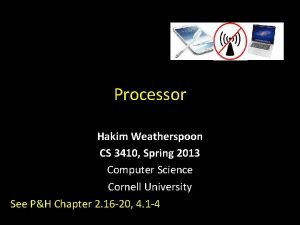Storage Hakim Weatherspoon CS 3410 Computer Science Cornell

































- Slides: 33

Storage Hakim Weatherspoon CS 3410 Computer Science Cornell University [Altinbuke, Walsh, Weatherspoon, Bala, Bracy, Mc. Kee, and Sirer]

Challenge • How do we store lots of data for a long time – Disk (Hard disk, floppy disk, …) – Tape (cassettes, backup, VHS, …) – CDs/DVDs 2

Challenge • How do we store lots of data for a long time – Disk (Hard disk, floppy disk, …Solid State Disk (SSD) – Tape (cassettes, backup, VHS, …) – CDs/DVDs – Non-Volitile Persistent Memory (NVM; e. g. 3 D Xpoint) 3

I/O System Characteristics • Dependability is important – Particularly for storage devices • Performance measures – Latency (response time) – Throughput (bandwidth) – Desktops & embedded systems Mainly interested in response time & diversity of devices – Servers Mainly interested in throughput & expandability of devices 4

Memory Hierarchy 16 KB 512 KB 2 GB 2 ns, random access registers/L 1 5 ns, random access L 2 20 -80 ns, random access DRAM 300 GB Disk 1 TB Tape 0 2 6 0 2 -8 ms, random access 100 s, sequential access 5

Memory Hierarchy 128 KB registers/L 1 2 ns, random access 4 MB L 2 256 GB DRAM 20 -80 ns, random access 6 TB Disk 2 -8 ms, random access 30 TB SSD 100 ns-10 us, random access 5 ns, random access Millions of IOPS (I/O per sec) 6

Memory Hierarchy 128 KB registers/L 1 4 MB L 2 256 GB DRAM 1 TB 6 TB 30 TB 2 ns, random access 5 ns, random access 20 -80 ns, random access Non-volatile memory 20 -100 ns, random access Disk SSD 2 -8 ms, random access 100 ns-10 us, random access Millions of IOPS (I/O per sec) 7

Memory Hierarchy 30 TB 245 B SSD 256 TB 248 B 10 PB 253 B Server 1 EB 260 B 0. 1 YB 267 B Rack of Servers Data Center Cloud 100 ns-10 us, random access Millions of IOPS (I/O per sec) 10 s of Disks 10 s of Servers 10 -100 s of Data Centers 8

The Rise of Cloud Computing • How big is Big Data in the Cloud? • Exabytes: Delivery of petabytes of storage daily Titan tech boom, randy katz, 2008 9

The Rise of Cloud Computing • How big is Big Data in the Cloud? • Most of the worlds data (and computation) hosted by few companies 10

The Rise of Cloud Computing • How big is Big Data in the Cloud? • Most of the worlds data (and computation) hosted by few companies 11

The Rise of Cloud Computing • The promise of the Cloud • ubiquitous, convenient, on-demand network access to a shared pool of configurable computing resources (e. g. , networks, servers, storage, applications, and services) that can be rapidly provisioned and released with minimal management effort or service provider interaction. NIST Cloud Definition 12

The Rise of Cloud Computing • The promise of the Cloud • ubiquitous, convenient, on-demand network access to a shared pool of configurable computing resources (e. g. , networks, servers, storage, applications, and services) that can be rapidly provisioned and released with minimal management effort or service provider interaction. NIST Cloud Definition 13

Tapes • Same basic principle for 8 -tracks, cassettes, VHS, . . . • Ferric Oxide Powder: ferromagnetic material • During recording, the audio signal is sent through the coil of wire to create a magnetic field in the core. • During playback, the motion of the tape creates a varying magnetic field in the core and therefore a signal in the coil. 0 0 1 0 1 14

Disks & CDs • Disks use same magnetic medium as tapes • concentric rings (not a spiral) • CDs & DVDs use optics and a single spiral track 15

Disk Physics Typical parameters : • 1 spindle • 1 arm assembly • 1 -4 platters • 1 -2 sides/platter • 1 head per side (but only 1 active head at a time) • 700 -20480 tracks/surface • 16 -1600 sectors/track 16

Disk Accesses • Accessing a disk requires: • specify sector: C (cylinder), H (head), and S (sector) • specify size: number of sectors to read or write • specify memory address • Performance: • • seek time: move the arm assembly to track Rotational delay: wait for sector to come around transfer time: get the bits off the disk Controller time: time for setup Track Sector Seek Time Rotation Delay 17

Example • Average time to read/write 512 -byte sector • • Disk rotation at 10, 000 RPM Seek time: 6 ms Transfer rate: 50 MB/sec Controller overhead: 0. 2 ms • Average time: • Seek time + rotational delay + transfer time + controller overhead • 6 ms + 0. 5 rotation/(10, 000 RPM) + 0. 5 KB/(50 MB/sec) + 0. 2 ms • 6. 0 + 3. 0 + 0. 01 + 0. 2 = 9. 2 ms 18

Disk Access Example • If actual average seek time is 2 ms • Average read time = 5. 2 ms 19

Disk Scheduling • Goal: minimize seek time • secondary goal: minimize rotational latency • FCFS (First come first served) • Shortest seek time • SCAN/Elevator • First service all requests in one direction • Then reverse and serve in opposite direction • Circular SCAN • Go off the edge and come to the beginning and start all over again 20

FCFS 21

SSTF 22

SCAN 23

C-SCAN 24

Disk Geometry: LBA • New machines use logical block addressing instead of CHS • machine presents illusion of an array of blocks, numbered 0 to N • Modern disks… • have varying number of sectors per track • roughly constant data density over disk • varying throughput over disk • remap and reorder blocks (to avoid defects) • completely obscure their actual physical geometry • have built-in caches to hide latencies when possible (but being careful of persistence requirements) • have internal software running on an embedded CPU 25

Flash Storage • Nonvolatile semiconductor storage • • 100× – 1000× faster than disk Smaller, lower power But more $/GB (between disk and DRAM) But, price is dropping and performance is increasing faster than disk 26

Flash Types • NOR flash: bit cell like a NOR gate • Random read/write access • Used for instruction memory in embedded systems • NAND flash: bit cell like a NAND gate • Denser (bits/area), but block-at-a-time access • Cheaper GB • Used for USB keys, media storage, … • Flash bits wears out after 1000’s of accesses • Not suitable for direct RAM or disk replacement • Flash has unusual interface • can only “reset” bits in large blocks 27

I/O vs. CPU Performance • Amdahl’s Law – Don’t neglect I/O performance as parallelism increases compute performance • Example – Benchmark takes 90 s CPU time, 10 s I/O time – Double the number of CPUs/2 years I/O unchanged Year CPU time I/O time Elapsed time % I/O time now 90 s 100 s 10% +2 45 s 10 s 55 s 18% +4 23 s 10 s 33 s 31% +6 11 s 10 s 21 s 47% 28

RAID • Redundant Arrays of Inexpensive Disks • Big idea: • Parallelism to gain performance • Redundancy to gain reliability 29

Raid 0 • Striping • Non-redundant disk array! 30

Raid 1 • Mirrored Disks! • More expensive • On failure use the extra copy 31

Raid 2 -3 -4 -5 -6 • Bit Level Striping and Parity Checks! • As level increases: • More guarantee against failure, more reliability Raid 2 Raid 4 Raid 3 Raid 5 • Better read/write performance 32

Summary • Disks provide nonvolatile memory • I/O performance measures • Throughput, response time • Dependability and cost very important • RAID • Redundancy for fault tolerance and speed 33
 Cs6410
Cs6410 Caller saved vs callee saved
Caller saved vs callee saved Cornell cs 3410
Cornell cs 3410 Cs 3410
Cs 3410 Cs 3410
Cs 3410 Rfc 3410
Rfc 3410 Cs 3410
Cs 3410 Cs 3410
Cs 3410 Cs 3410
Cs 3410 Cs 3410
Cs 3410 Kuva-yi milliye'yi amil ve milli iradeyi hakim kılma
Kuva-yi milliye'yi amil ve milli iradeyi hakim kılma Dedi budiman hakim
Dedi budiman hakim Hakim isa
Hakim isa Cecep maskanul hakim
Cecep maskanul hakim Metar few sct bkn ovc
Metar few sct bkn ovc Wasim hakim
Wasim hakim Hakim salim khan
Hakim salim khan Wasyawirhum fil amri
Wasyawirhum fil amri Hakim abdul hameed
Hakim abdul hameed Eropa kontinental
Eropa kontinental Mensturation
Mensturation Dr mazen al hakim
Dr mazen al hakim Hakim boulouiz
Hakim boulouiz Math is my favorite subject
Math is my favorite subject Web of science cornell
Web of science cornell Cornell notes rubric
Cornell notes rubric Primary storage vs secondary storage
Primary storage vs secondary storage Primary storage and secondary storage
Primary storage and secondary storage Uses rigid metallic platters
Uses rigid metallic platters Unified storage vs traditional storage
Unified storage vs traditional storage Kilobyte
Kilobyte Short term memory computer
Short term memory computer Computer peripherals storage devices
Computer peripherals storage devices Direct view storage tube in computer graphics
Direct view storage tube in computer graphics
